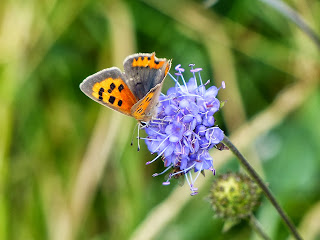After the very useful and enjoyable days spent with Judith in June and July finishing the vegetation quadrats for Long Term Monitoring Network, we went on to spend a morning together on Wheldrake Ings
followed by an afternoon at Thornton Ellers searching for new plant species, adding many new grasses, sedges and rushes to the
list.
With it being the end of August many butterflies were
still out on Wheldrake as we made our way through the Purple Loosestrife
towards the ditch-side where we started our search, passing along the way a
number of species (figures are day totals) - Peacock (22), Small Tortoiseshell
(202), Red Admiral (1), Small Copper (2), Comma (2), Small White (230),
Green-veined White (20), Speckled Wood (7).
Peaock (Inachis io) & Comma (Polygonum c-album)
Red Admiral (Vanessa atalanta)
Here we came across: Water Stitchwort, Lesser Water
Plantain, Celery-leaved Buttercup, Nodding Bur-marigold, Pink Water Speedwell,
Water Pepper, Toad Rush, Common Winter-cress, and Many-seeded Goosefoot to name a few.
Celery-leaved Buttercup (Ranunculus scleratus)
Toad Rush (Juncus bufonius)
Nodding Bur-marigold (Bidens cernua)
Pink Water Speedwell (Veronica catenata)
Not only were the butterflies out in good numbers, but also
many species of hoverfly, particularly the Helophilus genus, with H.trivittatus in abundance. We also came across a 'wasp mimic' which was new for the year - Sericomyia silentis.
Hoverfly (Helophilus trivittatus)
Wasp mimic (Sericomyia silentis)
From there we headed over to Thornton Ellers and in just a few hours we found 17 new
grasses/sedges/rushes bringing our list to 56 for the year. Thornton Ellers is best
described as an acidic fen surrounding alder woodland, here we came across species such as: Star Sedge,
Bladder Sedge, Carnation Sedge, Pill Sedge, Velvet Bent, Brown Bent, Creeping
Soft Grass and Purple Small-reed.
Star Sedge (Carex echinata)
Aptly named - Hairy Sedge (Carex hirta)
Even though it was late in the season many plant species could still be found such as - Enchanter's-nightshade, Harebell, Greater Bird's-foot Trefoil, Fen Bedstraw, Small Nettle, Common Stork's-bill, Climbing Corydalis and Field Pansy to name a few, however we also managed 7 new ones – some from the meadow and some
from along the arable edges: Sun Spurge, Fiddleneck, Corn Spurrey, Heath Groundsel,
Wall Speedwell, Parsley Piert and Marsh Cinquefoil.
Heath Groundsel (Senecio sylvaticus)
Fiddleneck (Amsinckia micrantha)
Small Nettle (Urtica urens)
Judith with - Purple Small-reed (Calamagrostis canescens)
The weather was kind to us throughout the whole day with the
sun bringing many butterflies to the Devil’s-bit Scabious which was out (one of the later flowering plants) and was humming with a variety of species: Small Copper (7),
Small Tortoiseshell (29), Peacock (1), Red Admiral (1), Painted Lady (1),
Brimstone (1), Common Blue (1), Wall Brown (1), Small White (11), Green-veined
White (7), and 6 Speckled Wood on the nearby brambles.
Small Copper (Lycaena phlaeas)
Green-veined White (Pieris napi)
Brimstone (Gonepteryx rhamni)
Many invertebrates were also found including several new ones for the year: Oieceoptoma thoracicum (Red-breasted Carrion Beetle), Chorthippus albomarginatus (Lesser Marsh Grasshopper), Piezodorus lituratus (Gorse Shield Bug), Psyllobora 22-punctata (22-spot Ladybird), Evacanthus interruptus (Yellow & black Leaf Hopper), Philaenus spumarius (Common Leaf Hopper), Poecilus versicolor (Ground Beetle) and Platycheirus granditarsus (Hoverfly).
Lesser Marsh Grasshopper (Chorthippus albomarginatus)
Common Green Grasshopper (Omocestus viridulus)
22-spot Ladybird (Psyllobora 22-punctata)
Common Flesh Fly (Sarcophaga carnaria)
Gorse Shield Bug (Piezodorus lituratus)























